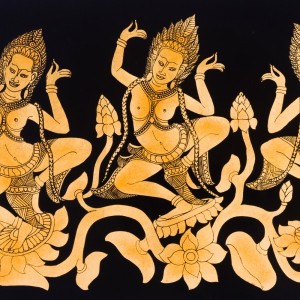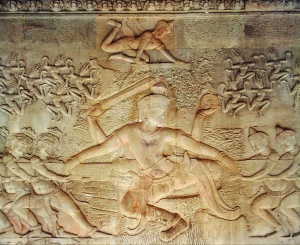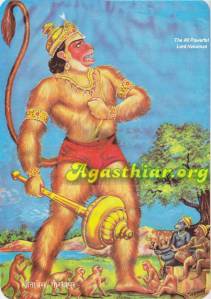Awhile back I read somewhere that people most commonly state that blue is their favorite color. It comes in so many shades and hues that it’s easy to imagine how people are drawn to it. I am no exception, although if pushed to name a favorite color I usually say orange. But I do love blue, especially shades of turquoise, and I can never resist the eye-popping electric blue.
Blue is associated with the sky and the sea, and is the color of stability and depth. It symbolizes loyalty, trust, faith, truth, wisdom, intelligence, and confidence. It also represents calmness and tranquility.
I love working with color and it’s symbolism, so this week I decided to pay homage to the color blue. But rather than discuss it’s attributes in full detail I wish to approach it a different way and instead take a look at some blue things.
Blue Mood: Even though blue is associated with many positive attributes, when it comes to emotion blue can take on a different quality. We are probably all familiar with the blue mood wherein we feel depressed and bummed out. I’m not sure how this expression came to be since blue generally has such positive qualities. Perhaps the blue mood is the extreme depths of the tranquil nature of blue.
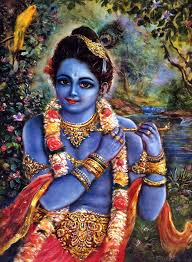
Krishna
Blue Blood: For some reason the notion of blue blood has always intrigued me. Most commonly a blue blood is someone of royal lineage. There are a number of Hindu deities that are depicted as having blue skin due to their blue blood. This blue blood concept even has a name, ichor, and I wrote a little about it in a post for the 2012 PBP. Here is what I had to say:
Ichor– Originally this was Homer’s word for the “blue blood” of the gods, which made these gods both blue and immortal. We commonly see these blue gods in the sacred art of India. In the European Middle Ages, these gods became reviled, as did their mystical blood. Now, instead of meaning magical blue gods blood, ichor means watery purulent discharge. Medieval churchmen claimed this was the blood of devils and the word has also been used to describe the blood of insects.
Aquamarine: I love stones and crystals and work with them a lot. One of my favorites is the crystal blue aquamarine (it can take on a green hue as well, but never mind that right now). I could write a whole post about aquamarine (should’ve thought about that one when we were still in A) but instead I will only share a few of the attributes of aquamarine.
Taken from “Crystal Power, Crystal Healing” by Michael Gienger:
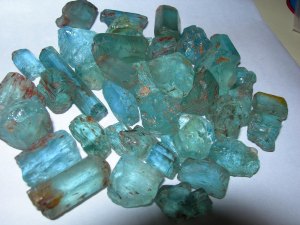
Aquamarine
Aquamarine encourages spiritual growth, foresight, farsightedness, mediumistic qualities and clairvoyance. It makes us upright and honest, goal-oriented, dynamic, persistent and successful.
Aquamarine bestows light-heartedness and a happy, relaxed disposition that is due to all things undertaken developing quickly and smoothly.
Aquamarine clears up confusion and stimulates orderliness, bringing unfinished business to a conclusion.
In my work with aquamarine I have found it to be great for spiritual work, particularly things like scrying or divination. It has also been a great stone to carry in my pocket when I need a lift, or a little luck.
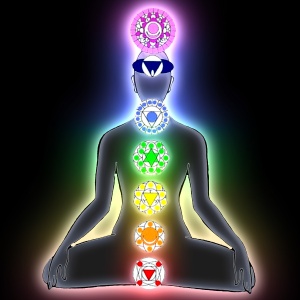
The seven chakras and their locations along the spine.
Blue Chakra: I almost made this my B post, but obviously I did not go that route. Instead I will simply summarize.
For those unfamiliar with the chakras, in short they are the energy centers of the body. I am most familiar with the seven chakras, but different schools of thought will have different numbers. The chakras start at the root, or base of the spine, and go up to the top of the head, or crown. C.G. Jung referred to the chakras as the “gateways of consciousness”. Each one is associated with different attributes in regards to its location in the body, and each one is also associated with a different color.
The blue chakra is found at the base of the neck and is also called the throat chakra and the fifth chakra. Because of its location it deals with everything related to sound on both the physical and metaphysical level. It is this chakra where feelings and emotions are transformed into expressions like laughing or crying.
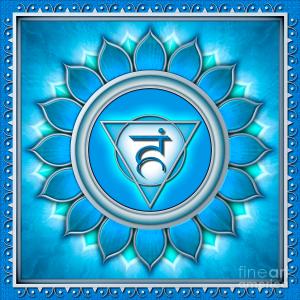
Blue Chakra
In working with the chakras one would strive for balance between the seven. Recognizing which chakras are low energy and which ones are overactive helps a person identify areas of physical, emotional, and spiritual growth they can work on. I find it to be a great practice to attempt to balance the chakras, although I have only experienced fleeting moments of total chakra harmony.
There are two other blue things I discussed in other posts, the good old blue jay, and the stone larimar. Please check those out if I peaked your curiosity in any way.
So there are some blue things to think about. My Gemini, magpie nature loves to do that, collect little tidbits and put them together. Hopefully you enjoyed this collection of blue things!
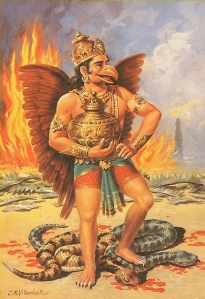
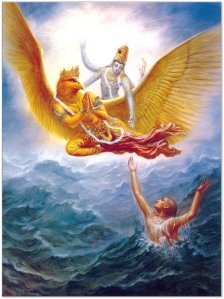 Now Garuda was really starving and frustrated, but little did he know Vishnu had been watching the whole scene. Vishnu went to Garuda and offered to let him perch on his arm and eat of his flesh. Garuda jumped at the chance for a meal and immediately bit into Vishnu’s arm, and was shocked to discover that his bite left no marks. This let Garuda know he was in the presence of a god and he pledged himself to him right then and there. And thus their relationship was born, and Garuda became the mount of Vishnu, allowing Vishnu to fly across the sky on his back.
Now Garuda was really starving and frustrated, but little did he know Vishnu had been watching the whole scene. Vishnu went to Garuda and offered to let him perch on his arm and eat of his flesh. Garuda jumped at the chance for a meal and immediately bit into Vishnu’s arm, and was shocked to discover that his bite left no marks. This let Garuda know he was in the presence of a god and he pledged himself to him right then and there. And thus their relationship was born, and Garuda became the mount of Vishnu, allowing Vishnu to fly across the sky on his back.



